Eventually the flight from Heathrow to Keflavik took to the air forty minutes late. Once we had climbed above the clouds we were heading towards a perpetual sunset that only disappeared when we descended through the cloud covering southwest Iceland where it was perpetual twilight.
There were only three of us on the flight, the other members of the group having arrived earlier. Progress through the formalities at the airport was rapid and we soon joined Oskar waiting to take us to our city centre hotel. The other group members had long retired so it was only a matter of getting to our room and getting some sleep.
After breakfast the following morning we all gathered in reception where Oskar was waiting for us. Our kit was loaded into a trailer to be pulled by a vehicle with very large tyres and driven by Siggy, while we piled ourselves into a super jeep for the journey to Mt. Hekla, a journey of about two and a half hours. We were all expecting the ascent of Hekla to involve 1000m of climbing. However, the advantage of having a super jeep was that it could get much higher up the mountain, thus reducing the effort needed by us. Parking at over 900m we were left with only 500m of ascent.
The route took us up steep slopes of very small, loose volcanic ash, across boulder fields of sharp edged volcanic rock and up snowfields. We were soon in cloud, seriously restricting any views we might have had. Known as “the Gateway to Hell”, Hekla is Iceland’s most dangerous volcano because of the regularity of its eruptions, generally speaking every ten years. It is now fourteen years since it last erupted and one is expected any day. The mountain showed signs of getting ready to erupt earlier in the year when the northern slopes began to bulge as the magma chamber filled. For a time the mountain was closed, anticipating an eruption was imminent, but when it didn’t happen it was reopened. It is being closely monitored for increased volcanic or seismic activity.
Our route, from the north, took us by recently formed, small craters, now dormant but capable of erupting at any time. The lava was predominantly jet black with splashes of rust coloured rock. To pick up a large piece took no effort at all as it was a honeycomb of sponge looking post eruption debris. It was all totally devoid of vegetation, plants finding it impossible to gain a foothold in the sterile conditions. As we approached the summit and the edge of the main crater the clouds parted and we were given extensive views all around but particularly to the west. Lunch was taken on the top in almost calm conditions and in pleasant temperatures, nothing like the experiences we had in other nearby locations last year. Stored in a watertight box on the summit is a ‘visitors’ book for summiteers to comment in. I obliged and commented on behalf of the group.
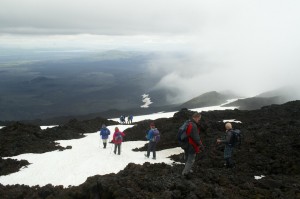 Descending by a slightly different route we spent more time descending and traversing more extensive snowfields. Stephen took the easier but slightly more precarious option of tobogganing down the snow on a survival bag.
Descending by a slightly different route we spent more time descending and traversing more extensive snowfields. Stephen took the easier but slightly more precarious option of tobogganing down the snow on a survival bag.
Returning to the super jeep the ascent of Hekla had been much easier than expected, largely because of the higher start and finish point. It is a stunning landscape of new earth. It is an environment completely devoid of vegetation of any kind and the regular eruptions mean that any possibilities of vegetation taking a hold are seriously hindered. I look forward to hearing of Hekla erupting again, knowing I have been there.
A bumpy two-hour ride in the super jeep took us to Landmannalaugar for our first night in a hut. It was incredibly crowded and, when we rounded the corner, had the appearance of Glastonbury with the number of tents filling the camping ground adjacent to the hut and a ring of vehicles of all shapes and sizes parked beyond.
The camp facilities were stretched to the limits as people cooked, ate, washed up, washed, showered etc. steam rose from the stream behind the hut and a little distance away a crowd of people bathed in the hot waters. After sweating our way up Hekla it seemed the best way to wash away the sweat as we wallowed in the stream before dinner. Dinner, grilled trout, potatoes and salad, was taken on bench tables outside our hut as the temperature was pleasant enough to sit outside. It really was a busy place and it was a relief to know that not everybody would be on the trail with us in the morning.
After dinner we had our first nominations for the daily award, the Puffin of Shame, awarded for words or acts so ridiculous that they deserve the responsibility of looking after a puffin while the rest of the group try to steal it at every opportunity. Grumpy Steve, so called because we had three Steves in the group, was awarded it this evening. While we were travelling to Landmannalaugar we stopped above a lake where Steve noticed a potential nude bather on the water’s edge. He could not get his binoculars out quick enough and having established the fact continued to watch.
That night we all slept in the same room on bench beds either side of the room. The events of the night, and subsequent nights, would fuel conversation for days to come. Amongst us were light sleepers, conscious to any sound or movement in the night hours. Others were more vocal in the night, snoring, mostly gently, on and off throughout the night. As gentle as it was it was enough to disturb some. I had the finger of blame pointed at me as one of those who snored. Speaking for myself, I never heard me snore but I did hear the others, who shall remain nameless for their own protection. The third group heard nothing on account of the fact that when they went to sleep they effectively died!
Crossing the hot spring the following morning, we climbed out of Landmannalaugar and left the bulk of the crowds behind us. Looking back there were so many tents it was impossible to count and we were pleased to be leaving for quieter places. We were heading into the Icelandic Highlands, an area of outstanding beauty and thermal activity. The valley floors, where water flowed freely, were covered in vegetation, largely mosses but some grasses also, and a myriad of colourful flowers. The slopes were mainly of bare rock with such a variety of colours from pale greys to yellow ochres and orangey reds. Gullies were streaked with snow left behind from the winter and, now, unlikely to disappear before they are added to by the onset of next winter. There was significantly more snow than we experienced last year.
All along the route were pockets of thermal activity with plumes of steam rising from small vents in the earth’s surface. As you drew closer bubbling water could be heard, often appearing above the surface in little cauldrons surrounded by toxic stones and mud. From a high point we were able to look back at the wide riverbed flowing from Landmannalaugar with its braided rivers intertwining and threading their way through the stones. Beyond, conical hills rose pointing their summits at the clouds above.
The further we delved into the highlands the more spectacular they became; bizarre shaped rocks, once molten but now frozen in time, dotted the skyline on craggy outcrops, vegetation became more sparse, revealing the vibrant colours of rock and earth and, as we gained height, we were able to look across a sea of rounded hilltops disappearing into the distance. There was very little evidence of wildlife, no telltale droppings or holes for small animals to scurry into, just the occasional birdsong. The lack of food on the ground probably accounted for the lack of large birds circling the skies above. We did come across a family of ptarmigan, a mother and numerous chicks, apparently unphased by our proximity to them. Perhaps that is why they are easily shot in the hunting season and decorate many an Icelander’s dinner table, especially at Christmas.
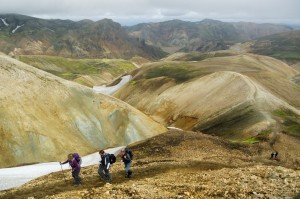 Snow became more widespread and we trudged our way across numerous snowfields littered with wind-blown volcanic dust across their wind-sculptured surfaces. It was stunning. However, the stunning vistas did not last forever as we were engulfed in cloud the higher we climbed. By mid afternoon we reached our overnight hut at Hrafntinnusker, perched just below the prow of the hill of our high point of the day.
Snow became more widespread and we trudged our way across numerous snowfields littered with wind-blown volcanic dust across their wind-sculptured surfaces. It was stunning. However, the stunning vistas did not last forever as we were engulfed in cloud the higher we climbed. By mid afternoon we reached our overnight hut at Hrafntinnusker, perched just below the prow of the hill of our high point of the day.
Feeling it too early to stop, I went to explore the surrounding area, making sure not to stray too far from the hut in case I became disorientated in the limited visibility. To one side of the hut was a scene of contrasting environments. Piled high against the north facing slope was deeply set snow, undercut in places creating an arch and snow caves with sculptured roofs. Adjacent to this cold scene were hot springs of bubbling water with plumes of steam rising to mix with the enveloping clouds.
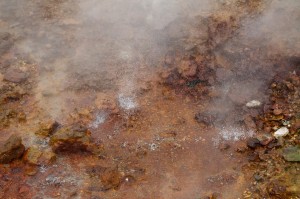 Vivid moss grew adjacent to the streams, adding contrast to the vibrant colours of the earth where nothing could grow. It was an enjoyable environment to explore and only the lure of tea and latticed tart filled with jam could tempt me back to the hut.
Vivid moss grew adjacent to the streams, adding contrast to the vibrant colours of the earth where nothing could grow. It was an enjoyable environment to explore and only the lure of tea and latticed tart filled with jam could tempt me back to the hut.
As afternoon drifted into evening and evening into night the drizzle began to fall and it became quite unpleasant outside. We were all confined to one room in the roof of the hut with mattresses laid out side by side on the floor. Again the night chorus disturbed some more than others.
After dinner we had the customary nominations and awards. This time it was Young Steve who disgraced himself during a conversation with Caz. On discovering that Caz worked at New College Worcester, a school for blind and visually impaired children, he said, “I guess that means teaching things like sign language?” Need I say more?
In the morning the hut and surrounding hills were shrouded in mist and the drizzle continued to fall. It may have only been light rain but it was the sort that was instantly very wet. Expecting the worst we all geared up for a wet day with layers covered with waterproofs and gaiters. No sooner had we started our descent from the hut the rain eased and the clouds began to disperse. All the waterproofs succeeded in doing now was making us hot and wet from the inside.
Realising the weather was improving, we divested ourselves of waterproofs and began to enjoy the walk much more. It was such a reward because, had the clouds remained, we would not have had such a superb day’s walk. The scenery was stunning and the contrast between the snowfields, of which there were many to cross, and the highland desert landscape was fantastic. The route was undulating without being too arduous and there was plenty of time to enjoy being there.
Crossing one small gully filled with Snow, Fraser’s foot went through into space below. Fortunately, he reacted quickly enough to avoid any more than just a foot going through. Big Steve, as opposed to Grumpy Steve or Young Steve, ventured into the cavern beneath the snow, located the hole and stuck his hand through, looking like something out of the Adams Family. The rest of us gave the weakness a wide birth.
We stopped for lunch in the most idyllic spot at the top of a gully on the edge of the highlands with the expanse of moss covered valleys, conical peaks, blue lakes, all overlooked by distant extensive glaciers. The contrast of colours was superb and it was a place you could never tire of viewing from. Eventually we did drag ourselves away and began our descent to the greenness below and the hut at Álftavatn on the lakeshore. Before we reached the hut we had our first river crossing. These are not a major event as the water tends not to be any deeper than knee level and the distances across are not too long. Most people manage unaided but when there are couples in the group it is nice to see husbands taking good care of their wives. Big Steve was very attentive to Elizabeth and guided her all the way across. Fraser, on the other hand, started out well, guiding Julie with care and attention, but when half way across he shrugged his shoulders, let go of Julie and left her floundering in the middle of the river while he strode manfully to the bank. While Big Steve’s approach was sickeningly slushy, Fraser’s behaviour towards his wife was inexcusable, so later, in the evening he was awarded the Puffin of Shame.
Again, we arrived at the hut in good time, so after a brief rest and time to sort out our kit, we ventured up a hill on the east side of the lake. I don’t know what sort of activities go on on this hill but its Icelandic name, when translated, means Porn Hill. I had been up it eleven months previously with the mixed group of visually impaired and sighted students from Worcester. As we left the hut and approached the hill we were plagued with flies, not the kind that give you nasty bites but ones that get everywhere. There were thousands of them, mostly about the head and face, and it was so easy to breathe them in. Fortunately, by the time we reached the ridge leading up to the summit there was sufficient breeze for them to disappear, thankfully.
The walk up the ridge is fabulous. Not only do you have extensive views to either side, to verdant green pyramidal peaks, glass like lakes, streaks of silver depicting where the rivers weave their way through the landscape and glistening glaciers, but there are some stunning rock formations thrust up from deep inside the earth before being molded and sculptured by the elements. These formations are worthy of any art gallery. The summit is one of those places that you could easily spend many an hour just absorbing all that is around you.
Back at the hut Fraser was duly awarded the Puffin of Shame for his callous treatment of his wife.
Leaving Álftavatn the next morning we were due to walk to the hut at Emstrur but it was fully booked and had been long before we committed to this trek. Instead, we were going to walk to a small hut at Hungursfit, about 10km out of our way. The walk started off well undulating over green ridges, with just one river crossing, for the first hour or so. Eventually we left the green behind as we crossed a relatively flat volcanic desert with little or no vegetation to break the grey monotony. At least the green slopes of volcanic cones rose steeply out of the greyness. By now we were walking along the dirt road and several kilometres of this began to get a little tedious.
Lunch was taken by a thunderous waterfall where the water was being squeezed through a narrow gap and down a ledge in the rock. As long as the sun was out a permanent rainbow hovered above the fall.
By mid afternoon we reached our hut, a small building with just a single room off the entrance. Bunks were on three sides of the room with a long dining table in the middle of the room. The wall without bunks was almost entirely window overlooking a stunning view. Below a river disappeared into a gorge with mountains rising above it. In the distance the glacial icecap shimmered in the afternoon sun.
Learning that there were some French trekkers joining us in the hut Mike and I decided to camp rather than disturb those in the hut. Putting up my tent became a bit of a mission. It was a tent I was not familiar with and this unfamiliarity, along with a fairly strong wind provided the group with some amusing entertainment. Fraser took pity on me and came to help but things did not improve until Caz came and took control of the situation. I feared I was in danger of seriously challenging for the Puffin of Shame. Caz also decided to camp but had her tent up before I could help her.
While I sorted myself out and maybe closed my eyes for a minute or two, most of the others ventured down to the gorge below for an explore. When they later returned they were full of enthusiasm for the gorge and the waterfalls that marked the beginning of it. I promised myself that I would make the time to go there for myself before we moved on.
That night, when it came to nominations and the presentation of the Puffin of Shame, I knew I had to deflect attention from myself. I pointed out that so far only men had won it. It was about time it went to a woman. For some reason Big Steve nominated his wife, Elizabeth, and suddenly the attention was deflected. Remarkably, despite the nomination being very flimsy, the vote went against Elizabeth and she had the privilege of being the first female custodian of the Puffin of Shame.
Following the best night’s sleep of the trip, we prepared for our walk to Pórsmörk. Rather than walk the extra 10km that our change of hut would entail, Siggy took half the group to Emstrur in his land cruiser while the rest of us explored the gorge the others had visited the previous afternoon. It was as impressive as they had said, and more so. A small waterfall, shortly followed by a larger one marked the entrance to a dramatically deep and narrow canyon. As I climbed down to a shelf closer to the water thousands of fritillaries fluttered from the grass and mosses dampened from the costant spray. The noise from the larger of the falls was deafening and it was dramatic to be standing on a rocky ledge at the side of it, feeling slightly giddy as the water raced by.
Climbing back up to the top of the gorge I ventured further downstream to where the river turned sharply away from me. From my vantage point I watched the river disappear, reappear and disappear again as it twisted its way through the norrowest of gorges.
Soon Siggy returned to take us to Emstrur to join the others.
The walk from Emstrur to Pórsmörk was beautiful and took us through a variety of landscapes, including, towards the end, a forest of miniature birch trees.
Soon after leaving Emstrur we dropped steeply to cross a river freshly released from the glacier a little further up the valley. Already the water is raging down, cutting a deep cleft in the rock and carving a gorge for itself, which gets deeper the further downstream it goes. It would be impossible to cross without a bridge from where we climb back up the other side.
The route continued undulating through stunning scenery as, gradually, a most noticeable peak came into view. It is called the Unicorn but it bares some resemblence to a rhinoceros and even more to a scarab beetle with horns at either end of its arched ridge. It is such a fascinating shape that it is hard to take your eyes off it, particularly as it changes the closer you get.
We were gradually losing height and in the distance you could see the ribboned river leaving Pórsmörk with the sea some distance to the south. Cloud was hugging the summits of the higher peaks to the east and occasionally they would drift towards us shedding rain as they passed over.
The question, “What do you do if you get lost in an Icelandic forest?” is often jokingly asked. The answer is, “Stand up!” That is almost true of the trees we encountered on this walk as we crossed a couple of low ridges on our journey into the main valley where our hut was situated. Oskar gave us the chance to climb a peak just to the south of the path and while he, Young Stephen and Caz climbed it, the rest of us went in the opposite direction straight to camp. This part of the walk required us to walk up the river bed for a couple of kilometres and included our last river crossing. As we walked up the river bed the showers came and went, but the sun never stopped shining, so we were treated to some wonderful rainbows arching across the valley with green and snow encrusted mountains behind.
I always thought that there was a pot of gold at each end of a rainbow, not that I have ever been able to find them. However, it was on this day that I learnt something new. You will have to look at the adjacent picture to understand. Rainbows emanate from the head of Grumpy Steve! If only he were worth his weight in gold!
Despite the facilities at the Básar being some of the best of any hut, our sleeping area seemed very cramped for the number of us wanting to sleep there. To make life more comfortable half the group chose to camp, almost guaranteeing that everybody got a good night’s sleep.
We sat outside enjoying a little beer in the evening sunshine awaiting our feast of barbequed legs of lamb. Unfortunately, just before the meal was served it started to rain and we had to dive indoors. That did not detract from the taste of the lamb, which was so succulent and tasty.
Throughout the day we could not help notice how Big Steve was always on hand to give Elizabeth help, or words of encouragement, or perform little chores for her. It was sickening to watch a grown man crumble in such a way. It was, therefore, no surprise that Elizabeth nominated him for creeping to her in the hope that she might forgive him for nominating her the previous evening. We all had to agree, so Big Steve was awarded the Puffin of Shame.
Our last day of trekking was by far our hardest. We were trekking up to the new lava fields created by the 2010 eruption of Eyjafjallajokull, the volcano that caused such havoc to air travel. Unfortunately, the rain of the previous evening had continued, on and off, throughout the night and looked set to continue for much of the day. We had little choice but to don our waterproof gear and get on with it. We had been incredibly lucky so far with the weather; to have just one wet day in a week of trekking was a bonus. Two members of the team, realising that the day was going to be hard, opted to take a ride round to Skogar with Siggy and enjoy a restful day. It was also an opportunity for us to say our farewells to Siggy and Hannah who, having delivered our kit to Skogar, were heading back to Reykjavik. They had been good company.
Caz and I were crossing familiar ground for the first three hours as we had taken this route with the group last year, only to be forced back by bad weather before reaching the top. This year the pace was much faster, not having blind students to guide over difficult terain. The combination of wet from the outside and sweat from the inside made the going difficult. It was only as we gained height, when the temperature dropped, that I began to feel more comfortable. Sadly, when it mattered, we were shrouded in cloud and it was impossible to see very much. The rain continued to fall heavily.
As we reached the top between the Eyjafjallajokull and Myrdalsjokull Glaciers we walked on contrasting jet black lava fields and white icefields. We were so grateful to have Oskar with us to guide us through the desolate, shrouded world. Even he had to resort to his GPS when it appeared that some of the marker posts had disappeared. Our direction was also thrown by the fact that the ice bridging a remarkably large river so close to the summit had collapsed and we had to detour some distance to get around it. Oskar was aiming for the hut just below the summit so we would have some shelter for our lunch. In finding it we were faced with an almost vertical cliff climb of about 20m up very loose volcanic ash dotted with what looked like firm rock outcrops but, in fact, turned out to be boulders resting on the surface of the ash. It was a fairly intense moment of scrambling for us all as it was impossible to gain a firm foothold and there was nothing reliable for the hands to hold.
Eventually we all made it, unscathed, and piled into the warm hut for some lunch. To greet us was a friendly warden and an even friendlier husky dog with one brown and one blue eye. They were there, not only to look after overnight lodgers but also to rescue people lost in this desolate place.
It was with some reluctance that we donned out wet socks, boots and waterproofs to, yet again, face the elements, which, if anything, had deteriorated further. Fortunately our departure from the hut was much more straight forward than our approach and we picked up the trail without difficulty. We crossed a few more icefields and lava flows before beginning our long descent to Skogar. By the time we began to emerge from the clouds we reached a second hut and picked up the stoney road, which made walking easier, if less interesting. This was the road that many an Icelander drove up when Eyjafallajokull first began to erupt harmlessly. It was only after a couple of weeks that the eruptions became more devastating.
The road soon drew alongside a large, fast flowing river disappearing into and reemerging from tunnels of ice. Thunderous waterfalls dropped it dramatically over lava flows as the weather showed signs of improving. The rain had stopped and we were able to start drying off.
Leaving the road, we crossed a bridge and picked up a path that followed the Skogar River. What we saw for the final few miles was so unexpected, so welcome and took our minds off our increasingly tiring limbs. The Skogar River, a fast flowing body of water, has cut a slit in the rock forming an impressive gorge with many thunderous waterfalls crashing over vertical shelves of lava. There were thirty five in total, all in excess of 20m and hardly a soul in sight to admire them. Many people visit Skogarfoss, the last and highest waterfall on the river, before it reaches the sea, but few venture up stream to see the other delights of this river. I couldn’t help think that if this was the UK we would have had walkways constructed, railings to protect visitors and tea shops. The Icelanders are so understated about what they have, thank goodness.
It was with a tinge of sadness that we descended the final steps from the top of the 62m Skogarfoss and the end of the trek. It was a fittingly impressive conclusion to such a fantastic day’s walk and trek. Although it was not quite over. We had another kilometre to walk to the hotel where we would find Julie and Elizabeth suitably shrivelled having spent most of the day pampering themselves in a hot tub and spa. They would have done had this been the right hotel. Oskar had thought we were staying there but we after a phonecall we continued for a further kilometre to a former school, now a hotel without a hot tub or spa. It was a relief to take my boots off, to release my wrinkled feet from their wet socks and climb into a hot shower.
Over dinner the beer helped soothe the aching limbs and there was a huge feeling of satisfaction and achievement. Big Steve had done a good job in looking after the puffin and we had our final ceremony after dinner. Claire had confessed earlier in the day to having had some difficulty going to the toilet when we stopped for lunch. The only receptacle she could find was a men’s urinal so it was with some difficulty that she performed. Her confession was sufficient for her to be awarded the Puffin of Shame.
We had a leisurely start the next morning while we waited for the super jeep to be dropped off. We were not in any rush to get back to Reykjavik as the hotel would not be available until the afternoon. Oskar wanted to show us the wreckage of an American Dakota, which made an emergency landing on the beach during a storm in 1973. Rather than rescue it in its entirety the Americans decided to just take the important bits away, leaving the fusilage. Now children, and bigger boys, can clamber over it and imagine.
Heading back towards Reykjavik we made one more stop at Seljalandsfoss, an impressive waterfall with a path going full circle behind it. The wind catches the water easily, varying its descending pattern and sending spray into the path of those walking round it. Here it was crowded, being one of the highlights for touring groups travelling around Iceland. I wonder how many of them would consider venturing to some of the stunning waterfalls we had seen yesterday? Very few, I suspect and I am grateful of the fact that tourism has not spoiled Iceland.
Back in Reykjavik, a number of us decided we would like to go whale watching. It was a very pleasant evening, gloriously sunny and a flat sea. Sailing out to sea we saw a number of puffins scurrying across the water. I never realised just how small they were, much smaller than our puffin, which we had carried throughout the trek. We saw three minky whales in total but it was not at all exciting. They hardly rise out of the water and their dorsal fins are remarkably small. Whilst it would have been good to see whales leaping or displaying their flukes as they dived it was not important. It was just a pleasure to be relaxing on a boat in glorious sunshine.
Our last night together in Reykjavik we celebrated an excellent trip with a meal at the Argentine Steak House. We thanked Oskar for his care and attention throughout and for guiding us through some stunning Icelandic scenery. We rebuked Claire for being a poor custodian of the Puffin of Shame, leaving him in her room and not looking after him at all. The puffin is now in the capable hands of Oskar who will look after him until next year. Yes, there will be another trip next year to explore the beautifully remote north east.
The following morning the group began to split up. Mike and Catherine picked up their campervan to explore other areas, while the rest of us visited the Blue Lagoon en route to the airport. Grumpy Steve, Young Stephen and Caz headed back into Reykjavik to explore lava tubes, Big Steve and Elizabeth to continue their extended tour of Iceland and the rest of us to catch our flight home.
The more I see of Iceland the more I like it. I like the people who are warm and friendly, the scenery is unique and stunning and the travelling companions are a lot of fun. Without wishing my life away, I cannot wait for next year.

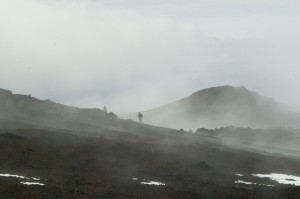
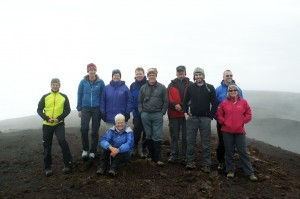
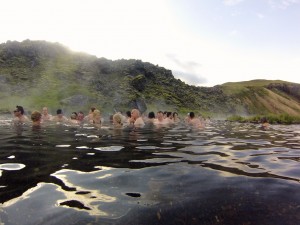
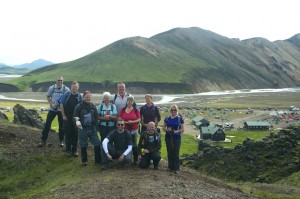
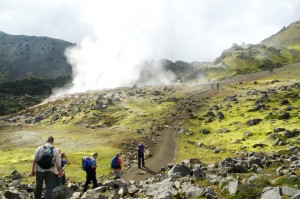
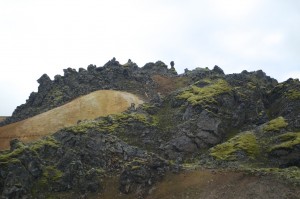
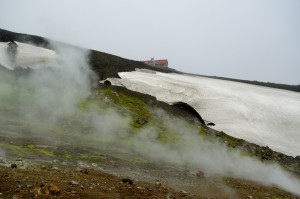
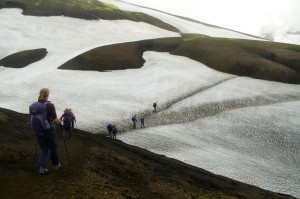
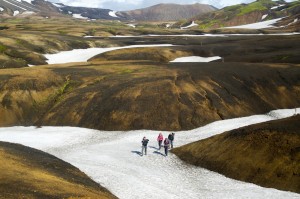
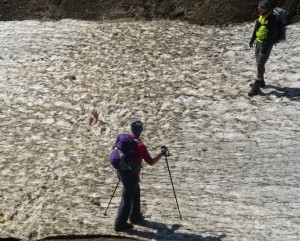
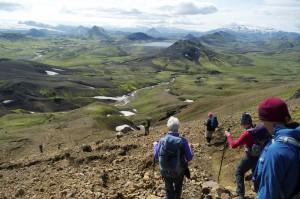
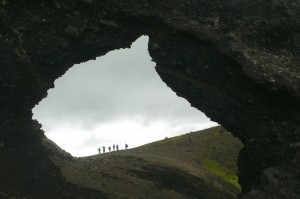
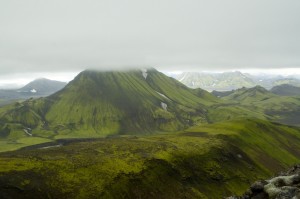
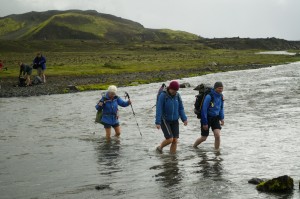
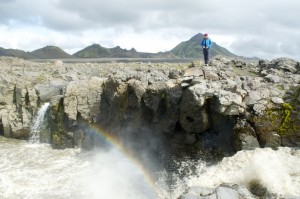
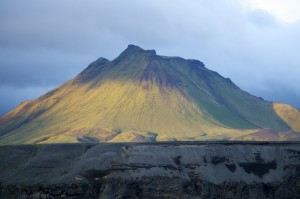
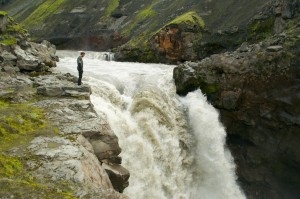
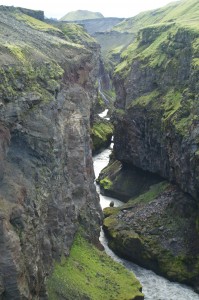
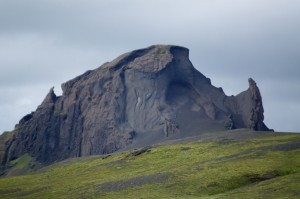
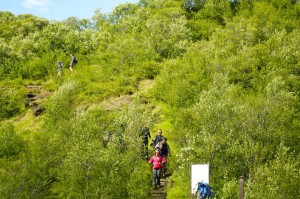
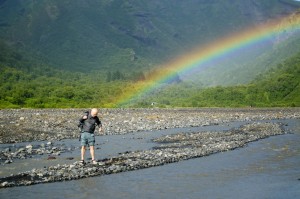
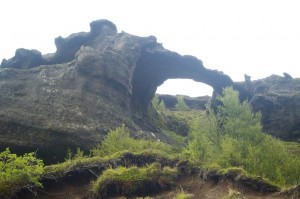
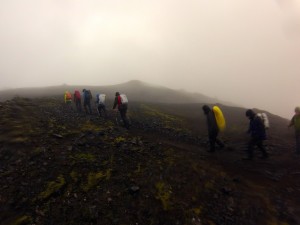
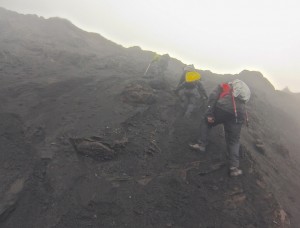
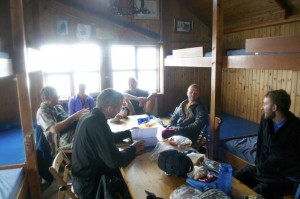
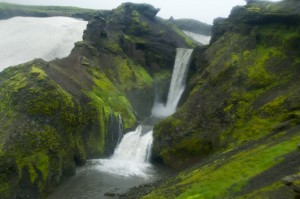
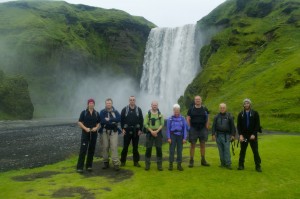
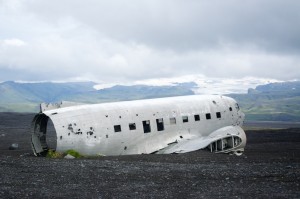
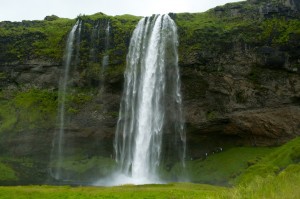
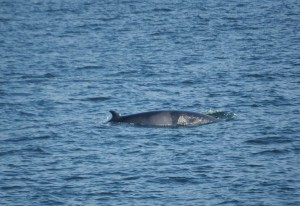
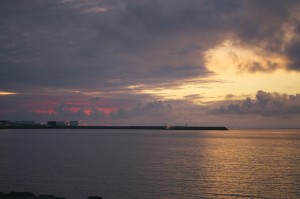

A great read. It sounds like it was a great trip.
Hi Russ,
It was a superb trip. Glad to see you are having a great bike trip but what I don’t understand is how Pauline can be on telly tonight and be in Rioja at the same time!